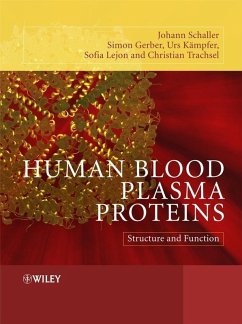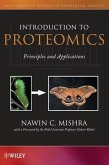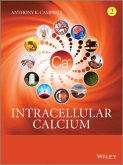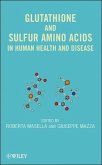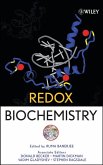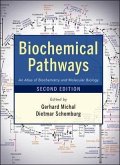Johann Schaller, Simon Gerber, Urs Kaempfer, Sofia Lejon, Christian Trachsel
Human Blood Plasma Proteins (eBook, PDF)
Structure and Function
150,99 €
150,99 €
inkl. MwSt.
Sofort per Download lieferbar

0 °P sammeln
150,99 €
Als Download kaufen

150,99 €
inkl. MwSt.
Sofort per Download lieferbar

0 °P sammeln
Jetzt verschenken
Alle Infos zum eBook verschenken
150,99 €
inkl. MwSt.
Sofort per Download lieferbar
Alle Infos zum eBook verschenken

0 °P sammeln
Johann Schaller, Simon Gerber, Urs Kaempfer, Sofia Lejon, Christian Trachsel
Human Blood Plasma Proteins (eBook, PDF)
Structure and Function
- Format: PDF
- Merkliste
- Auf die Merkliste
- Bewerten Bewerten
- Teilen
- Produkt teilen
- Produkterinnerung
- Produkterinnerung

Bitte loggen Sie sich zunächst in Ihr Kundenkonto ein oder registrieren Sie sich bei
bücher.de, um das eBook-Abo tolino select nutzen zu können.
Hier können Sie sich einloggen
Hier können Sie sich einloggen
Sie sind bereits eingeloggt. Klicken Sie auf 2. tolino select Abo, um fortzufahren.

Bitte loggen Sie sich zunächst in Ihr Kundenkonto ein oder registrieren Sie sich bei bücher.de, um das eBook-Abo tolino select nutzen zu können.
Human Blood Plasma Proteins gives an overview of the proteins found in human blood plasma, with special emphasis on their structure and function and relationship to pathological states and disease. Topics covered include: introduction to blood components and blood plasma proteins | blood plasma protein domains, motifs and repeats | blood plasma protein families and posttranslational modifications | blood coagulation and fibrinolysis | the complement system | the immune system | enzymes | inhibitors | lipoproteins | hormones | cytokines and growth factors | transport and storage
The…mehr
- Geräte: PC
- mit Kopierschutz
- eBook Hilfe
- Größe: 14.28MB
Andere Kunden interessierten sich auch für
![Introduction to Proteomics (eBook, PDF) Introduction to Proteomics (eBook, PDF)]() Nawin C. MishraIntroduction to Proteomics (eBook, PDF)101,99 €
Nawin C. MishraIntroduction to Proteomics (eBook, PDF)101,99 €![Prediction of Protein Structures, Functions, and Interactions (eBook, PDF) Prediction of Protein Structures, Functions, and Interactions (eBook, PDF)]() Prediction of Protein Structures, Functions, and Interactions (eBook, PDF)134,99 €
Prediction of Protein Structures, Functions, and Interactions (eBook, PDF)134,99 €![Intracellular Calcium (eBook, PDF) Intracellular Calcium (eBook, PDF)]() Anthony K. CampbellIntracellular Calcium (eBook, PDF)242,99 €
Anthony K. CampbellIntracellular Calcium (eBook, PDF)242,99 €![Glutathione and Sulfur Amino Acids in Human Health and Disease (eBook, PDF) Glutathione and Sulfur Amino Acids in Human Health and Disease (eBook, PDF)]() Roberta MasellaGlutathione and Sulfur Amino Acids in Human Health and Disease (eBook, PDF)165,99 €
Roberta MasellaGlutathione and Sulfur Amino Acids in Human Health and Disease (eBook, PDF)165,99 €![Redox Biochemistry (eBook, PDF) Redox Biochemistry (eBook, PDF)]() Redox Biochemistry (eBook, PDF)136,99 €
Redox Biochemistry (eBook, PDF)136,99 €![Biochemical Pathways (eBook, PDF) Biochemical Pathways (eBook, PDF)]() Biochemical Pathways (eBook, PDF)122,99 €
Biochemical Pathways (eBook, PDF)122,99 €![Metabolomics in Practice (eBook, PDF) Metabolomics in Practice (eBook, PDF)]() Metabolomics in Practice (eBook, PDF)97,99 €
Metabolomics in Practice (eBook, PDF)97,99 €-
-
-
Human Blood Plasma Proteins gives an overview of the proteins found in human blood plasma, with special emphasis on their structure and function and relationship to pathological states and disease. Topics covered include:
The information of each protein discussed in this book in some detail is summarised at the end of each chapter in a Data Sheet, where one can find the most important data of each protein at one glance. Full cross-referencing to protein databases is given and many of the proteins discussed are accompanied by their 3D structure.
Attractively presented in full colour, Human Blood Plasma Proteins is an essential atlas of this proteome for anyone working in biochemistry, protein chemistry and proteomics, structural biology, and medicine.
- introduction to blood components and blood plasma proteins
- blood plasma protein domains, motifs and repeats
- blood plasma protein families and posttranslational modifications
- blood coagulation and fibrinolysis
- the complement system
- the immune system
- enzymes
- inhibitors
- lipoproteins
- hormones
- cytokines and growth factors
- transport and storage
The information of each protein discussed in this book in some detail is summarised at the end of each chapter in a Data Sheet, where one can find the most important data of each protein at one glance. Full cross-referencing to protein databases is given and many of the proteins discussed are accompanied by their 3D structure.
Attractively presented in full colour, Human Blood Plasma Proteins is an essential atlas of this proteome for anyone working in biochemistry, protein chemistry and proteomics, structural biology, and medicine.
Dieser Download kann aus rechtlichen Gründen nur mit Rechnungsadresse in D ausgeliefert werden.
Produktdetails
- Produktdetails
- Verlag: John Wiley & Sons
- Erscheinungstermin: 2. August 2008
- Englisch
- ISBN-13: 9780470724361
- Artikelnr.: 37299161
- Verlag: John Wiley & Sons
- Erscheinungstermin: 2. August 2008
- Englisch
- ISBN-13: 9780470724361
- Artikelnr.: 37299161
- Herstellerkennzeichnung Die Herstellerinformationen sind derzeit nicht verfügbar.
Johann Schaller and Simon Gerber are the authors of Human Blood Plasma Proteins: Structure and Function, published by Wiley.
Preface xi
1 Introduction 1
References 3
Part I 5
2 Blood Components 7
2.1 Introduction 7
2.2 Short History 7
2.3 Blood Components 8
2.3.1 Blood cells 8
2.3.2 Blood plasma 12
2.3.3 The blood group system 13
References 15
Data Sheet 16
3 Blood Plasma Proteins 17
3.1 Introduction 17
3.2 Short History 17
3.3 Classification of Blood Plasma Proteins 17
References 20
Part II 21
4 Domains, Motifs and Repeats 23
4.1 Introduction 23
4.2 The Epidermal Growth Factor (EGF)-Like Domain 24
4.3 The Kringle Domain 26
4.4 The g-Carboxyglutamic Acid-Rich (Gla) Domain 27
4.5 The PAN/Apple Domain 28
4.6 The Sushi/CCP/SCR Domain 30
4.7 The Fibronectin Type I, the Fibronectin Type II Collagen-Binding and
the Fibronectin Type III Domains 31
4.8 The Coagulation Factors 5/8 Type C Domain (FA58C) 32
4.9 The Thrombospondin Type I Repeat (TSP1) 34
4.10 The VWFA, VWFC and VWFD Domains 35
4.11 The Cystatin-Like Domain 36
4.12 The LDL-Receptor Class A (LDLRA) and Class B (LDLRB) Domains 36
4.13 The C-Terminal Cystine Knot (CTCK) Structure 38
4.14 The Anaphylatoxin Domain 40
4.15 The CUB Domain 40
4.16 The NTR Domain 41
4.17 The C-Type Lectin (CTL) Domain 42
4.18 The Ig-Like Domain 43
References 44
5 Protein Families 47
5.1 Introduction 47
5.2 Serine Proteases: The Trypsin Family 47
5.3 Serine Protease Inhibitors (Serpins) 48
5.4 The a2-Macroglobulin Family 50
5.5 The Serum Albumin Family 52
5.6 The Pancreatic Trypsin Inhibitor (Kunitz) Family Signature 52
5.7 The Kazal Serine Protease Inhibitors Family Signature 53
5.8 The Multicopper Oxidase Family 54
5.9 The Lipocalin Family 54
5.10 The Globin Family 55
5.11 The Glucagon/Gastric Inhibitory Polypeptide (GIP)/Secretin/ Vasoactive
Intestinal Peptide (VIP) Family 56
5.12 The Glycoprotein Hormone Family 58
5.13 Membrane Attack Complex Components/Perforin Signature (The Complement
C6/C7/C8/C9 Family) 59
5.14 The Lipase Family 60
5.15 Hormone Families and Signatures 61
5.15.1 The erythropoietin/thrombopoietin signature 61
5.15.2 The corticotropin-releasing factor family 61
5.15.3 The gonadotropin-releasing hormone signature 62
5.15.4 The calcitonin/CGRP/IAPP family 62
5.15.5 The gastrin/cholecystokinin family 62
5.15.6 The insulin family 62
5.16 Growth Factor Families 64
5.16.1 The platelet-derived growth factor family 64
5.16.2 The transforming growth factor-b family 64
5.17 Cytokine Families 65
5.17.1 The tumor necrosis factor family 65
5.17.2 The interferon a, b and d family 66
5.18 Interleukin Families and Signatures 66
5.18.1 The interleukin-1 signature 66
5.18.2 The interleukin-2 signature 67
5.18.3 The interleukin-4/-13 signature 68
5.18.4 The interleukin-6/granulocyte colony-stimulating
factor/myelomonocytic growth factor family 68
5.18.5 The interleukin-7 and -9 signature 69
5.18.6 Interleukin-10 family 69
5.19 The Small Cytokine (Intercrine/Chemokine) Family and Signature 70
References 72
6 Posttranslational Modifications 75
6.1 Introduction 75
6.2 Databases for Posttranslational Modifications (PTMs) 75
6.3 Disulfide Bridges 75
6.4 Glycosylation 77
6.5 Phosphorylation 79
6.5.1 Ser/Thr phosphorylation sites 80
6.5.2 Tyr phosphorylation site 81
6.6 Hydroxylation 81
6.6.1 Aspartic acid and asparagine hydroxylation site 81
6.7 Sulfation 82
6.8 Acylation and Alkylation 84
6.9 Amidation 84
6.10 Carboxylation 84
6.11 Crosslinks 85
6.11.1 The isoglutamyl cysteine thioester bond 85
6.11.2 The isopeptide bond 85
References 86
Part III 89
7 Blood Coagulation and Fibrinolysis 91
7.1 Introduction 91
7.1.1 Definition of haemostasis 91
7.2 Primary Haemostasis 92
7.3 The Coagulation Cascade 95
7.4 The Fibrinolytic System 109
7.5 The Regulation of Blood Coagulation and Fibrinolysis 114
7.6 The Kinin and Angiotensin/Renin Systems 116
References 119
Data Sheets 121
8 The Complement System 151
8.1 Introduction 151
8.1.1 Nomenclature 152
8.2 The Classical Pathway 152
8.2.1 The anaphylatoxins C3a, C4a and C5a 160
8.3 The Alternative Pathway 160
8.4 The Terminal Components of the Complement System 162
8.5 Components of Complement Activation 165
8.6 Regulation of the Complement System 167
References 171
Data Sheets 172
9 The Immune System 195
9.1 Introduction 195
9.2 Immunoglobulins 196
9.3 Antibody Diversity 203
9.4 Major Histocompatibility Complex (MHC) Proteins 205
9.5 Innate Immune System 209
9.6 Other Proteins 213
References 214
Data Sheets 215
10 Enzymes 231
10.1 Introduction 231
10.2 EC 1: Oxidoreductases 231
10.2.1 EC 1.11: peroxidases 233
10.3 EC 2: Transferases 236
10.3.1 EC 2.3: acyltransferases 236
10.3.2 EC 2.6: transfer of nitrogenous group 237
10.3.3 EC 2.7: transfer of phosphorous-containing groups 237
10.4 EC 3: Hydrolases 239
10.4.1 EC 3.1: esterases (ester bond) 239
10.4.2 EC 3.2: glycosylases (sugars) 242
10.4.3 EC 3.4: peptidases (peptide bonds) 243
EC 3.4.17: metallocarboxypeptidases 243
EC 3.4.21: serine endopeptidases (serine proteases) 243
EC 3.4.22: cysteine endopeptidases (cysteine proteases) 250
EC 3.4.23: aspartic endopeptidases (aspartic proteases) 253
10.5 EC 5: Isomerases 255
10.5.1 EC 5.3: oxidoreductases (intramolecular) 256
References 257
Data Sheets 258
11 Inhibitors 283
11.1 Introduction 283
11.2 Serine Protease Inhibitors (Serpins) 283
11.2.1 Introduction 283
11.2.2 Structural properties 284
11.2.3 Inhibitory reaction 286
11.3 Blood Coagulation and Fibrinolysis 286
11.3.1 Blood coagulation 287
11.3.2 Fibrinolysis 291
11.4 The Complement System 292
11.5 General Inhibitors 293
11.6 Other Serpins 294
11.7 Other Inhibitors 294
References 298
Data Sheets 299
12 Lipoproteins 317
12.1 Introduction 317
12.2 Enzymes in Lipoprotein Metabolism 318
12.3 Apolipoproteins 320
12.4 LDL and VLDL Receptors 324
12.5 Serum Amyloid A Proteins 325
References 326
Data Sheets 327
13 Hormones 343
13.1 Introduction 343
13.2 Pancreatic Hormones 343
13.3 Gastrointestinal Hormones 346
13.4 Calcium-Related Hormones 347
13.5 Hormone-Releasing Factors, Their Trophic Hormones and Related Hormones
349
13.6 Vasopressin and Oxytocin 355
13.7 Natural Opioid Peptides 356
13.8 Vasoactive Peptides 357
13.9 Erythropoietin and Thrombopoietin 359
13.10 Others 360
13.10.1 Adiponectin 360
13.10.2 Islet amyloid polypeptide 360
References 361
Data Sheets 362
14 Cytokines and Growth Factors 393
14.1 Introduction 393
14.2 Interleukin Families 395
14.2.1 Interleukin-1 family 395
14.2.2 Interleukin-2 family 397
14.2.3 Interleukin-3 family 397
14.2.4 Interleukin-4/interleukin-13 family 398
14.2.5 Interleukin-5 family 398
14.2.6 Interleukin-6 family 400
14.2.7 Interleukin-7/interleukin-9 family 402
14.2.8 Interleukin-10 family 402
14.2.9 Interleukin-15 family 404
14.2.10 Granulocyte-macrophage colony-stimulating factor family 404
14.3 Tumour Necrosis Factor Family 405
14.4 The Interferon Family 406
14.4.1 The interferon a/b family 406
14.4.2 The interferon g family 408
14.5 Chemokines 408
14.5.1 The intercrine a/chemokine CxC family 409
14.5.2 The intercrine b/chemokine CC family 410
14.6 The Platelet-Derived Growth Factor/Vascular Endothelial Growth Factor
Family 413
14.7 Transforming Growth Factor-b Family 414
14.8 Miscellaneous 415
14.8.1 The nerve growth factor-b family 415
14.8.2 Epidermal growth factor 417
14.8.3 Insulin-like growth factor binding proteins 418
References 418
Data Sheets 419
15 Transport and Storage 451
15.1 Introduction 451
15.2 The Serum Albumin Family 451
15.3 The Globin Family 452
15.3.1 Haptoglobin 456
15.4 Iron Transport and Storage 457
15.4.1 Iron oxidation: ceruloplasmin 457
15.4.2 Iron transport proteins: transferrins 459
15.4.3 Iron storage 462
15.4.4 Heme transport and iron recovery: hemopexin 462
15.5 Transport of Hormones, Steroids and Vitamins 463
15.5.1 Hormone transport proteins 464
15.5.2 Steroid transport proteins 467
15.5.3 Vitamin A transport protein 467
15.6 Other Transport Proteins in Plasma 468
15.6.1 Selenoproteins 468
References 468
Data Sheets 469
16 Additional Proteins 487
16.1 Introduction 487
16.2 Additional Blood Plasma Proteins 487
Data Sheets 492
Appendix 503
Glossary 515
Index 521
1 Introduction 1
References 3
Part I 5
2 Blood Components 7
2.1 Introduction 7
2.2 Short History 7
2.3 Blood Components 8
2.3.1 Blood cells 8
2.3.2 Blood plasma 12
2.3.3 The blood group system 13
References 15
Data Sheet 16
3 Blood Plasma Proteins 17
3.1 Introduction 17
3.2 Short History 17
3.3 Classification of Blood Plasma Proteins 17
References 20
Part II 21
4 Domains, Motifs and Repeats 23
4.1 Introduction 23
4.2 The Epidermal Growth Factor (EGF)-Like Domain 24
4.3 The Kringle Domain 26
4.4 The g-Carboxyglutamic Acid-Rich (Gla) Domain 27
4.5 The PAN/Apple Domain 28
4.6 The Sushi/CCP/SCR Domain 30
4.7 The Fibronectin Type I, the Fibronectin Type II Collagen-Binding and
the Fibronectin Type III Domains 31
4.8 The Coagulation Factors 5/8 Type C Domain (FA58C) 32
4.9 The Thrombospondin Type I Repeat (TSP1) 34
4.10 The VWFA, VWFC and VWFD Domains 35
4.11 The Cystatin-Like Domain 36
4.12 The LDL-Receptor Class A (LDLRA) and Class B (LDLRB) Domains 36
4.13 The C-Terminal Cystine Knot (CTCK) Structure 38
4.14 The Anaphylatoxin Domain 40
4.15 The CUB Domain 40
4.16 The NTR Domain 41
4.17 The C-Type Lectin (CTL) Domain 42
4.18 The Ig-Like Domain 43
References 44
5 Protein Families 47
5.1 Introduction 47
5.2 Serine Proteases: The Trypsin Family 47
5.3 Serine Protease Inhibitors (Serpins) 48
5.4 The a2-Macroglobulin Family 50
5.5 The Serum Albumin Family 52
5.6 The Pancreatic Trypsin Inhibitor (Kunitz) Family Signature 52
5.7 The Kazal Serine Protease Inhibitors Family Signature 53
5.8 The Multicopper Oxidase Family 54
5.9 The Lipocalin Family 54
5.10 The Globin Family 55
5.11 The Glucagon/Gastric Inhibitory Polypeptide (GIP)/Secretin/ Vasoactive
Intestinal Peptide (VIP) Family 56
5.12 The Glycoprotein Hormone Family 58
5.13 Membrane Attack Complex Components/Perforin Signature (The Complement
C6/C7/C8/C9 Family) 59
5.14 The Lipase Family 60
5.15 Hormone Families and Signatures 61
5.15.1 The erythropoietin/thrombopoietin signature 61
5.15.2 The corticotropin-releasing factor family 61
5.15.3 The gonadotropin-releasing hormone signature 62
5.15.4 The calcitonin/CGRP/IAPP family 62
5.15.5 The gastrin/cholecystokinin family 62
5.15.6 The insulin family 62
5.16 Growth Factor Families 64
5.16.1 The platelet-derived growth factor family 64
5.16.2 The transforming growth factor-b family 64
5.17 Cytokine Families 65
5.17.1 The tumor necrosis factor family 65
5.17.2 The interferon a, b and d family 66
5.18 Interleukin Families and Signatures 66
5.18.1 The interleukin-1 signature 66
5.18.2 The interleukin-2 signature 67
5.18.3 The interleukin-4/-13 signature 68
5.18.4 The interleukin-6/granulocyte colony-stimulating
factor/myelomonocytic growth factor family 68
5.18.5 The interleukin-7 and -9 signature 69
5.18.6 Interleukin-10 family 69
5.19 The Small Cytokine (Intercrine/Chemokine) Family and Signature 70
References 72
6 Posttranslational Modifications 75
6.1 Introduction 75
6.2 Databases for Posttranslational Modifications (PTMs) 75
6.3 Disulfide Bridges 75
6.4 Glycosylation 77
6.5 Phosphorylation 79
6.5.1 Ser/Thr phosphorylation sites 80
6.5.2 Tyr phosphorylation site 81
6.6 Hydroxylation 81
6.6.1 Aspartic acid and asparagine hydroxylation site 81
6.7 Sulfation 82
6.8 Acylation and Alkylation 84
6.9 Amidation 84
6.10 Carboxylation 84
6.11 Crosslinks 85
6.11.1 The isoglutamyl cysteine thioester bond 85
6.11.2 The isopeptide bond 85
References 86
Part III 89
7 Blood Coagulation and Fibrinolysis 91
7.1 Introduction 91
7.1.1 Definition of haemostasis 91
7.2 Primary Haemostasis 92
7.3 The Coagulation Cascade 95
7.4 The Fibrinolytic System 109
7.5 The Regulation of Blood Coagulation and Fibrinolysis 114
7.6 The Kinin and Angiotensin/Renin Systems 116
References 119
Data Sheets 121
8 The Complement System 151
8.1 Introduction 151
8.1.1 Nomenclature 152
8.2 The Classical Pathway 152
8.2.1 The anaphylatoxins C3a, C4a and C5a 160
8.3 The Alternative Pathway 160
8.4 The Terminal Components of the Complement System 162
8.5 Components of Complement Activation 165
8.6 Regulation of the Complement System 167
References 171
Data Sheets 172
9 The Immune System 195
9.1 Introduction 195
9.2 Immunoglobulins 196
9.3 Antibody Diversity 203
9.4 Major Histocompatibility Complex (MHC) Proteins 205
9.5 Innate Immune System 209
9.6 Other Proteins 213
References 214
Data Sheets 215
10 Enzymes 231
10.1 Introduction 231
10.2 EC 1: Oxidoreductases 231
10.2.1 EC 1.11: peroxidases 233
10.3 EC 2: Transferases 236
10.3.1 EC 2.3: acyltransferases 236
10.3.2 EC 2.6: transfer of nitrogenous group 237
10.3.3 EC 2.7: transfer of phosphorous-containing groups 237
10.4 EC 3: Hydrolases 239
10.4.1 EC 3.1: esterases (ester bond) 239
10.4.2 EC 3.2: glycosylases (sugars) 242
10.4.3 EC 3.4: peptidases (peptide bonds) 243
EC 3.4.17: metallocarboxypeptidases 243
EC 3.4.21: serine endopeptidases (serine proteases) 243
EC 3.4.22: cysteine endopeptidases (cysteine proteases) 250
EC 3.4.23: aspartic endopeptidases (aspartic proteases) 253
10.5 EC 5: Isomerases 255
10.5.1 EC 5.3: oxidoreductases (intramolecular) 256
References 257
Data Sheets 258
11 Inhibitors 283
11.1 Introduction 283
11.2 Serine Protease Inhibitors (Serpins) 283
11.2.1 Introduction 283
11.2.2 Structural properties 284
11.2.3 Inhibitory reaction 286
11.3 Blood Coagulation and Fibrinolysis 286
11.3.1 Blood coagulation 287
11.3.2 Fibrinolysis 291
11.4 The Complement System 292
11.5 General Inhibitors 293
11.6 Other Serpins 294
11.7 Other Inhibitors 294
References 298
Data Sheets 299
12 Lipoproteins 317
12.1 Introduction 317
12.2 Enzymes in Lipoprotein Metabolism 318
12.3 Apolipoproteins 320
12.4 LDL and VLDL Receptors 324
12.5 Serum Amyloid A Proteins 325
References 326
Data Sheets 327
13 Hormones 343
13.1 Introduction 343
13.2 Pancreatic Hormones 343
13.3 Gastrointestinal Hormones 346
13.4 Calcium-Related Hormones 347
13.5 Hormone-Releasing Factors, Their Trophic Hormones and Related Hormones
349
13.6 Vasopressin and Oxytocin 355
13.7 Natural Opioid Peptides 356
13.8 Vasoactive Peptides 357
13.9 Erythropoietin and Thrombopoietin 359
13.10 Others 360
13.10.1 Adiponectin 360
13.10.2 Islet amyloid polypeptide 360
References 361
Data Sheets 362
14 Cytokines and Growth Factors 393
14.1 Introduction 393
14.2 Interleukin Families 395
14.2.1 Interleukin-1 family 395
14.2.2 Interleukin-2 family 397
14.2.3 Interleukin-3 family 397
14.2.4 Interleukin-4/interleukin-13 family 398
14.2.5 Interleukin-5 family 398
14.2.6 Interleukin-6 family 400
14.2.7 Interleukin-7/interleukin-9 family 402
14.2.8 Interleukin-10 family 402
14.2.9 Interleukin-15 family 404
14.2.10 Granulocyte-macrophage colony-stimulating factor family 404
14.3 Tumour Necrosis Factor Family 405
14.4 The Interferon Family 406
14.4.1 The interferon a/b family 406
14.4.2 The interferon g family 408
14.5 Chemokines 408
14.5.1 The intercrine a/chemokine CxC family 409
14.5.2 The intercrine b/chemokine CC family 410
14.6 The Platelet-Derived Growth Factor/Vascular Endothelial Growth Factor
Family 413
14.7 Transforming Growth Factor-b Family 414
14.8 Miscellaneous 415
14.8.1 The nerve growth factor-b family 415
14.8.2 Epidermal growth factor 417
14.8.3 Insulin-like growth factor binding proteins 418
References 418
Data Sheets 419
15 Transport and Storage 451
15.1 Introduction 451
15.2 The Serum Albumin Family 451
15.3 The Globin Family 452
15.3.1 Haptoglobin 456
15.4 Iron Transport and Storage 457
15.4.1 Iron oxidation: ceruloplasmin 457
15.4.2 Iron transport proteins: transferrins 459
15.4.3 Iron storage 462
15.4.4 Heme transport and iron recovery: hemopexin 462
15.5 Transport of Hormones, Steroids and Vitamins 463
15.5.1 Hormone transport proteins 464
15.5.2 Steroid transport proteins 467
15.5.3 Vitamin A transport protein 467
15.6 Other Transport Proteins in Plasma 468
15.6.1 Selenoproteins 468
References 468
Data Sheets 469
16 Additional Proteins 487
16.1 Introduction 487
16.2 Additional Blood Plasma Proteins 487
Data Sheets 492
Appendix 503
Glossary 515
Index 521
Preface xi
1 Introduction 1
References 3
Part I 5
2 Blood Components 7
2.1 Introduction 7
2.2 Short History 7
2.3 Blood Components 8
2.3.1 Blood cells 8
2.3.2 Blood plasma 12
2.3.3 The blood group system 13
References 15
Data Sheet 16
3 Blood Plasma Proteins 17
3.1 Introduction 17
3.2 Short History 17
3.3 Classification of Blood Plasma Proteins 17
References 20
Part II 21
4 Domains, Motifs and Repeats 23
4.1 Introduction 23
4.2 The Epidermal Growth Factor (EGF)-Like Domain 24
4.3 The Kringle Domain 26
4.4 The g-Carboxyglutamic Acid-Rich (Gla) Domain 27
4.5 The PAN/Apple Domain 28
4.6 The Sushi/CCP/SCR Domain 30
4.7 The Fibronectin Type I, the Fibronectin Type II Collagen-Binding and
the Fibronectin Type III Domains 31
4.8 The Coagulation Factors 5/8 Type C Domain (FA58C) 32
4.9 The Thrombospondin Type I Repeat (TSP1) 34
4.10 The VWFA, VWFC and VWFD Domains 35
4.11 The Cystatin-Like Domain 36
4.12 The LDL-Receptor Class A (LDLRA) and Class B (LDLRB) Domains 36
4.13 The C-Terminal Cystine Knot (CTCK) Structure 38
4.14 The Anaphylatoxin Domain 40
4.15 The CUB Domain 40
4.16 The NTR Domain 41
4.17 The C-Type Lectin (CTL) Domain 42
4.18 The Ig-Like Domain 43
References 44
5 Protein Families 47
5.1 Introduction 47
5.2 Serine Proteases: The Trypsin Family 47
5.3 Serine Protease Inhibitors (Serpins) 48
5.4 The a2-Macroglobulin Family 50
5.5 The Serum Albumin Family 52
5.6 The Pancreatic Trypsin Inhibitor (Kunitz) Family Signature 52
5.7 The Kazal Serine Protease Inhibitors Family Signature 53
5.8 The Multicopper Oxidase Family 54
5.9 The Lipocalin Family 54
5.10 The Globin Family 55
5.11 The Glucagon/Gastric Inhibitory Polypeptide (GIP)/Secretin/ Vasoactive
Intestinal Peptide (VIP) Family 56
5.12 The Glycoprotein Hormone Family 58
5.13 Membrane Attack Complex Components/Perforin Signature (The Complement
C6/C7/C8/C9 Family) 59
5.14 The Lipase Family 60
5.15 Hormone Families and Signatures 61
5.15.1 The erythropoietin/thrombopoietin signature 61
5.15.2 The corticotropin-releasing factor family 61
5.15.3 The gonadotropin-releasing hormone signature 62
5.15.4 The calcitonin/CGRP/IAPP family 62
5.15.5 The gastrin/cholecystokinin family 62
5.15.6 The insulin family 62
5.16 Growth Factor Families 64
5.16.1 The platelet-derived growth factor family 64
5.16.2 The transforming growth factor-b family 64
5.17 Cytokine Families 65
5.17.1 The tumor necrosis factor family 65
5.17.2 The interferon a, b and d family 66
5.18 Interleukin Families and Signatures 66
5.18.1 The interleukin-1 signature 66
5.18.2 The interleukin-2 signature 67
5.18.3 The interleukin-4/-13 signature 68
5.18.4 The interleukin-6/granulocyte colony-stimulating
factor/myelomonocytic growth factor family 68
5.18.5 The interleukin-7 and -9 signature 69
5.18.6 Interleukin-10 family 69
5.19 The Small Cytokine (Intercrine/Chemokine) Family and Signature 70
References 72
6 Posttranslational Modifications 75
6.1 Introduction 75
6.2 Databases for Posttranslational Modifications (PTMs) 75
6.3 Disulfide Bridges 75
6.4 Glycosylation 77
6.5 Phosphorylation 79
6.5.1 Ser/Thr phosphorylation sites 80
6.5.2 Tyr phosphorylation site 81
6.6 Hydroxylation 81
6.6.1 Aspartic acid and asparagine hydroxylation site 81
6.7 Sulfation 82
6.8 Acylation and Alkylation 84
6.9 Amidation 84
6.10 Carboxylation 84
6.11 Crosslinks 85
6.11.1 The isoglutamyl cysteine thioester bond 85
6.11.2 The isopeptide bond 85
References 86
Part III 89
7 Blood Coagulation and Fibrinolysis 91
7.1 Introduction 91
7.1.1 Definition of haemostasis 91
7.2 Primary Haemostasis 92
7.3 The Coagulation Cascade 95
7.4 The Fibrinolytic System 109
7.5 The Regulation of Blood Coagulation and Fibrinolysis 114
7.6 The Kinin and Angiotensin/Renin Systems 116
References 119
Data Sheets 121
8 The Complement System 151
8.1 Introduction 151
8.1.1 Nomenclature 152
8.2 The Classical Pathway 152
8.2.1 The anaphylatoxins C3a, C4a and C5a 160
8.3 The Alternative Pathway 160
8.4 The Terminal Components of the Complement System 162
8.5 Components of Complement Activation 165
8.6 Regulation of the Complement System 167
References 171
Data Sheets 172
9 The Immune System 195
9.1 Introduction 195
9.2 Immunoglobulins 196
9.3 Antibody Diversity 203
9.4 Major Histocompatibility Complex (MHC) Proteins 205
9.5 Innate Immune System 209
9.6 Other Proteins 213
References 214
Data Sheets 215
10 Enzymes 231
10.1 Introduction 231
10.2 EC 1: Oxidoreductases 231
10.2.1 EC 1.11: peroxidases 233
10.3 EC 2: Transferases 236
10.3.1 EC 2.3: acyltransferases 236
10.3.2 EC 2.6: transfer of nitrogenous group 237
10.3.3 EC 2.7: transfer of phosphorous-containing groups 237
10.4 EC 3: Hydrolases 239
10.4.1 EC 3.1: esterases (ester bond) 239
10.4.2 EC 3.2: glycosylases (sugars) 242
10.4.3 EC 3.4: peptidases (peptide bonds) 243
EC 3.4.17: metallocarboxypeptidases 243
EC 3.4.21: serine endopeptidases (serine proteases) 243
EC 3.4.22: cysteine endopeptidases (cysteine proteases) 250
EC 3.4.23: aspartic endopeptidases (aspartic proteases) 253
10.5 EC 5: Isomerases 255
10.5.1 EC 5.3: oxidoreductases (intramolecular) 256
References 257
Data Sheets 258
11 Inhibitors 283
11.1 Introduction 283
11.2 Serine Protease Inhibitors (Serpins) 283
11.2.1 Introduction 283
11.2.2 Structural properties 284
11.2.3 Inhibitory reaction 286
11.3 Blood Coagulation and Fibrinolysis 286
11.3.1 Blood coagulation 287
11.3.2 Fibrinolysis 291
11.4 The Complement System 292
11.5 General Inhibitors 293
11.6 Other Serpins 294
11.7 Other Inhibitors 294
References 298
Data Sheets 299
12 Lipoproteins 317
12.1 Introduction 317
12.2 Enzymes in Lipoprotein Metabolism 318
12.3 Apolipoproteins 320
12.4 LDL and VLDL Receptors 324
12.5 Serum Amyloid A Proteins 325
References 326
Data Sheets 327
13 Hormones 343
13.1 Introduction 343
13.2 Pancreatic Hormones 343
13.3 Gastrointestinal Hormones 346
13.4 Calcium-Related Hormones 347
13.5 Hormone-Releasing Factors, Their Trophic Hormones and Related Hormones
349
13.6 Vasopressin and Oxytocin 355
13.7 Natural Opioid Peptides 356
13.8 Vasoactive Peptides 357
13.9 Erythropoietin and Thrombopoietin 359
13.10 Others 360
13.10.1 Adiponectin 360
13.10.2 Islet amyloid polypeptide 360
References 361
Data Sheets 362
14 Cytokines and Growth Factors 393
14.1 Introduction 393
14.2 Interleukin Families 395
14.2.1 Interleukin-1 family 395
14.2.2 Interleukin-2 family 397
14.2.3 Interleukin-3 family 397
14.2.4 Interleukin-4/interleukin-13 family 398
14.2.5 Interleukin-5 family 398
14.2.6 Interleukin-6 family 400
14.2.7 Interleukin-7/interleukin-9 family 402
14.2.8 Interleukin-10 family 402
14.2.9 Interleukin-15 family 404
14.2.10 Granulocyte-macrophage colony-stimulating factor family 404
14.3 Tumour Necrosis Factor Family 405
14.4 The Interferon Family 406
14.4.1 The interferon a/b family 406
14.4.2 The interferon g family 408
14.5 Chemokines 408
14.5.1 The intercrine a/chemokine CxC family 409
14.5.2 The intercrine b/chemokine CC family 410
14.6 The Platelet-Derived Growth Factor/Vascular Endothelial Growth Factor
Family 413
14.7 Transforming Growth Factor-b Family 414
14.8 Miscellaneous 415
14.8.1 The nerve growth factor-b family 415
14.8.2 Epidermal growth factor 417
14.8.3 Insulin-like growth factor binding proteins 418
References 418
Data Sheets 419
15 Transport and Storage 451
15.1 Introduction 451
15.2 The Serum Albumin Family 451
15.3 The Globin Family 452
15.3.1 Haptoglobin 456
15.4 Iron Transport and Storage 457
15.4.1 Iron oxidation: ceruloplasmin 457
15.4.2 Iron transport proteins: transferrins 459
15.4.3 Iron storage 462
15.4.4 Heme transport and iron recovery: hemopexin 462
15.5 Transport of Hormones, Steroids and Vitamins 463
15.5.1 Hormone transport proteins 464
15.5.2 Steroid transport proteins 467
15.5.3 Vitamin A transport protein 467
15.6 Other Transport Proteins in Plasma 468
15.6.1 Selenoproteins 468
References 468
Data Sheets 469
16 Additional Proteins 487
16.1 Introduction 487
16.2 Additional Blood Plasma Proteins 487
Data Sheets 492
Appendix 503
Glossary 515
Index 521
1 Introduction 1
References 3
Part I 5
2 Blood Components 7
2.1 Introduction 7
2.2 Short History 7
2.3 Blood Components 8
2.3.1 Blood cells 8
2.3.2 Blood plasma 12
2.3.3 The blood group system 13
References 15
Data Sheet 16
3 Blood Plasma Proteins 17
3.1 Introduction 17
3.2 Short History 17
3.3 Classification of Blood Plasma Proteins 17
References 20
Part II 21
4 Domains, Motifs and Repeats 23
4.1 Introduction 23
4.2 The Epidermal Growth Factor (EGF)-Like Domain 24
4.3 The Kringle Domain 26
4.4 The g-Carboxyglutamic Acid-Rich (Gla) Domain 27
4.5 The PAN/Apple Domain 28
4.6 The Sushi/CCP/SCR Domain 30
4.7 The Fibronectin Type I, the Fibronectin Type II Collagen-Binding and
the Fibronectin Type III Domains 31
4.8 The Coagulation Factors 5/8 Type C Domain (FA58C) 32
4.9 The Thrombospondin Type I Repeat (TSP1) 34
4.10 The VWFA, VWFC and VWFD Domains 35
4.11 The Cystatin-Like Domain 36
4.12 The LDL-Receptor Class A (LDLRA) and Class B (LDLRB) Domains 36
4.13 The C-Terminal Cystine Knot (CTCK) Structure 38
4.14 The Anaphylatoxin Domain 40
4.15 The CUB Domain 40
4.16 The NTR Domain 41
4.17 The C-Type Lectin (CTL) Domain 42
4.18 The Ig-Like Domain 43
References 44
5 Protein Families 47
5.1 Introduction 47
5.2 Serine Proteases: The Trypsin Family 47
5.3 Serine Protease Inhibitors (Serpins) 48
5.4 The a2-Macroglobulin Family 50
5.5 The Serum Albumin Family 52
5.6 The Pancreatic Trypsin Inhibitor (Kunitz) Family Signature 52
5.7 The Kazal Serine Protease Inhibitors Family Signature 53
5.8 The Multicopper Oxidase Family 54
5.9 The Lipocalin Family 54
5.10 The Globin Family 55
5.11 The Glucagon/Gastric Inhibitory Polypeptide (GIP)/Secretin/ Vasoactive
Intestinal Peptide (VIP) Family 56
5.12 The Glycoprotein Hormone Family 58
5.13 Membrane Attack Complex Components/Perforin Signature (The Complement
C6/C7/C8/C9 Family) 59
5.14 The Lipase Family 60
5.15 Hormone Families and Signatures 61
5.15.1 The erythropoietin/thrombopoietin signature 61
5.15.2 The corticotropin-releasing factor family 61
5.15.3 The gonadotropin-releasing hormone signature 62
5.15.4 The calcitonin/CGRP/IAPP family 62
5.15.5 The gastrin/cholecystokinin family 62
5.15.6 The insulin family 62
5.16 Growth Factor Families 64
5.16.1 The platelet-derived growth factor family 64
5.16.2 The transforming growth factor-b family 64
5.17 Cytokine Families 65
5.17.1 The tumor necrosis factor family 65
5.17.2 The interferon a, b and d family 66
5.18 Interleukin Families and Signatures 66
5.18.1 The interleukin-1 signature 66
5.18.2 The interleukin-2 signature 67
5.18.3 The interleukin-4/-13 signature 68
5.18.4 The interleukin-6/granulocyte colony-stimulating
factor/myelomonocytic growth factor family 68
5.18.5 The interleukin-7 and -9 signature 69
5.18.6 Interleukin-10 family 69
5.19 The Small Cytokine (Intercrine/Chemokine) Family and Signature 70
References 72
6 Posttranslational Modifications 75
6.1 Introduction 75
6.2 Databases for Posttranslational Modifications (PTMs) 75
6.3 Disulfide Bridges 75
6.4 Glycosylation 77
6.5 Phosphorylation 79
6.5.1 Ser/Thr phosphorylation sites 80
6.5.2 Tyr phosphorylation site 81
6.6 Hydroxylation 81
6.6.1 Aspartic acid and asparagine hydroxylation site 81
6.7 Sulfation 82
6.8 Acylation and Alkylation 84
6.9 Amidation 84
6.10 Carboxylation 84
6.11 Crosslinks 85
6.11.1 The isoglutamyl cysteine thioester bond 85
6.11.2 The isopeptide bond 85
References 86
Part III 89
7 Blood Coagulation and Fibrinolysis 91
7.1 Introduction 91
7.1.1 Definition of haemostasis 91
7.2 Primary Haemostasis 92
7.3 The Coagulation Cascade 95
7.4 The Fibrinolytic System 109
7.5 The Regulation of Blood Coagulation and Fibrinolysis 114
7.6 The Kinin and Angiotensin/Renin Systems 116
References 119
Data Sheets 121
8 The Complement System 151
8.1 Introduction 151
8.1.1 Nomenclature 152
8.2 The Classical Pathway 152
8.2.1 The anaphylatoxins C3a, C4a and C5a 160
8.3 The Alternative Pathway 160
8.4 The Terminal Components of the Complement System 162
8.5 Components of Complement Activation 165
8.6 Regulation of the Complement System 167
References 171
Data Sheets 172
9 The Immune System 195
9.1 Introduction 195
9.2 Immunoglobulins 196
9.3 Antibody Diversity 203
9.4 Major Histocompatibility Complex (MHC) Proteins 205
9.5 Innate Immune System 209
9.6 Other Proteins 213
References 214
Data Sheets 215
10 Enzymes 231
10.1 Introduction 231
10.2 EC 1: Oxidoreductases 231
10.2.1 EC 1.11: peroxidases 233
10.3 EC 2: Transferases 236
10.3.1 EC 2.3: acyltransferases 236
10.3.2 EC 2.6: transfer of nitrogenous group 237
10.3.3 EC 2.7: transfer of phosphorous-containing groups 237
10.4 EC 3: Hydrolases 239
10.4.1 EC 3.1: esterases (ester bond) 239
10.4.2 EC 3.2: glycosylases (sugars) 242
10.4.3 EC 3.4: peptidases (peptide bonds) 243
EC 3.4.17: metallocarboxypeptidases 243
EC 3.4.21: serine endopeptidases (serine proteases) 243
EC 3.4.22: cysteine endopeptidases (cysteine proteases) 250
EC 3.4.23: aspartic endopeptidases (aspartic proteases) 253
10.5 EC 5: Isomerases 255
10.5.1 EC 5.3: oxidoreductases (intramolecular) 256
References 257
Data Sheets 258
11 Inhibitors 283
11.1 Introduction 283
11.2 Serine Protease Inhibitors (Serpins) 283
11.2.1 Introduction 283
11.2.2 Structural properties 284
11.2.3 Inhibitory reaction 286
11.3 Blood Coagulation and Fibrinolysis 286
11.3.1 Blood coagulation 287
11.3.2 Fibrinolysis 291
11.4 The Complement System 292
11.5 General Inhibitors 293
11.6 Other Serpins 294
11.7 Other Inhibitors 294
References 298
Data Sheets 299
12 Lipoproteins 317
12.1 Introduction 317
12.2 Enzymes in Lipoprotein Metabolism 318
12.3 Apolipoproteins 320
12.4 LDL and VLDL Receptors 324
12.5 Serum Amyloid A Proteins 325
References 326
Data Sheets 327
13 Hormones 343
13.1 Introduction 343
13.2 Pancreatic Hormones 343
13.3 Gastrointestinal Hormones 346
13.4 Calcium-Related Hormones 347
13.5 Hormone-Releasing Factors, Their Trophic Hormones and Related Hormones
349
13.6 Vasopressin and Oxytocin 355
13.7 Natural Opioid Peptides 356
13.8 Vasoactive Peptides 357
13.9 Erythropoietin and Thrombopoietin 359
13.10 Others 360
13.10.1 Adiponectin 360
13.10.2 Islet amyloid polypeptide 360
References 361
Data Sheets 362
14 Cytokines and Growth Factors 393
14.1 Introduction 393
14.2 Interleukin Families 395
14.2.1 Interleukin-1 family 395
14.2.2 Interleukin-2 family 397
14.2.3 Interleukin-3 family 397
14.2.4 Interleukin-4/interleukin-13 family 398
14.2.5 Interleukin-5 family 398
14.2.6 Interleukin-6 family 400
14.2.7 Interleukin-7/interleukin-9 family 402
14.2.8 Interleukin-10 family 402
14.2.9 Interleukin-15 family 404
14.2.10 Granulocyte-macrophage colony-stimulating factor family 404
14.3 Tumour Necrosis Factor Family 405
14.4 The Interferon Family 406
14.4.1 The interferon a/b family 406
14.4.2 The interferon g family 408
14.5 Chemokines 408
14.5.1 The intercrine a/chemokine CxC family 409
14.5.2 The intercrine b/chemokine CC family 410
14.6 The Platelet-Derived Growth Factor/Vascular Endothelial Growth Factor
Family 413
14.7 Transforming Growth Factor-b Family 414
14.8 Miscellaneous 415
14.8.1 The nerve growth factor-b family 415
14.8.2 Epidermal growth factor 417
14.8.3 Insulin-like growth factor binding proteins 418
References 418
Data Sheets 419
15 Transport and Storage 451
15.1 Introduction 451
15.2 The Serum Albumin Family 451
15.3 The Globin Family 452
15.3.1 Haptoglobin 456
15.4 Iron Transport and Storage 457
15.4.1 Iron oxidation: ceruloplasmin 457
15.4.2 Iron transport proteins: transferrins 459
15.4.3 Iron storage 462
15.4.4 Heme transport and iron recovery: hemopexin 462
15.5 Transport of Hormones, Steroids and Vitamins 463
15.5.1 Hormone transport proteins 464
15.5.2 Steroid transport proteins 467
15.5.3 Vitamin A transport protein 467
15.6 Other Transport Proteins in Plasma 468
15.6.1 Selenoproteins 468
References 468
Data Sheets 469
16 Additional Proteins 487
16.1 Introduction 487
16.2 Additional Blood Plasma Proteins 487
Data Sheets 492
Appendix 503
Glossary 515
Index 521
